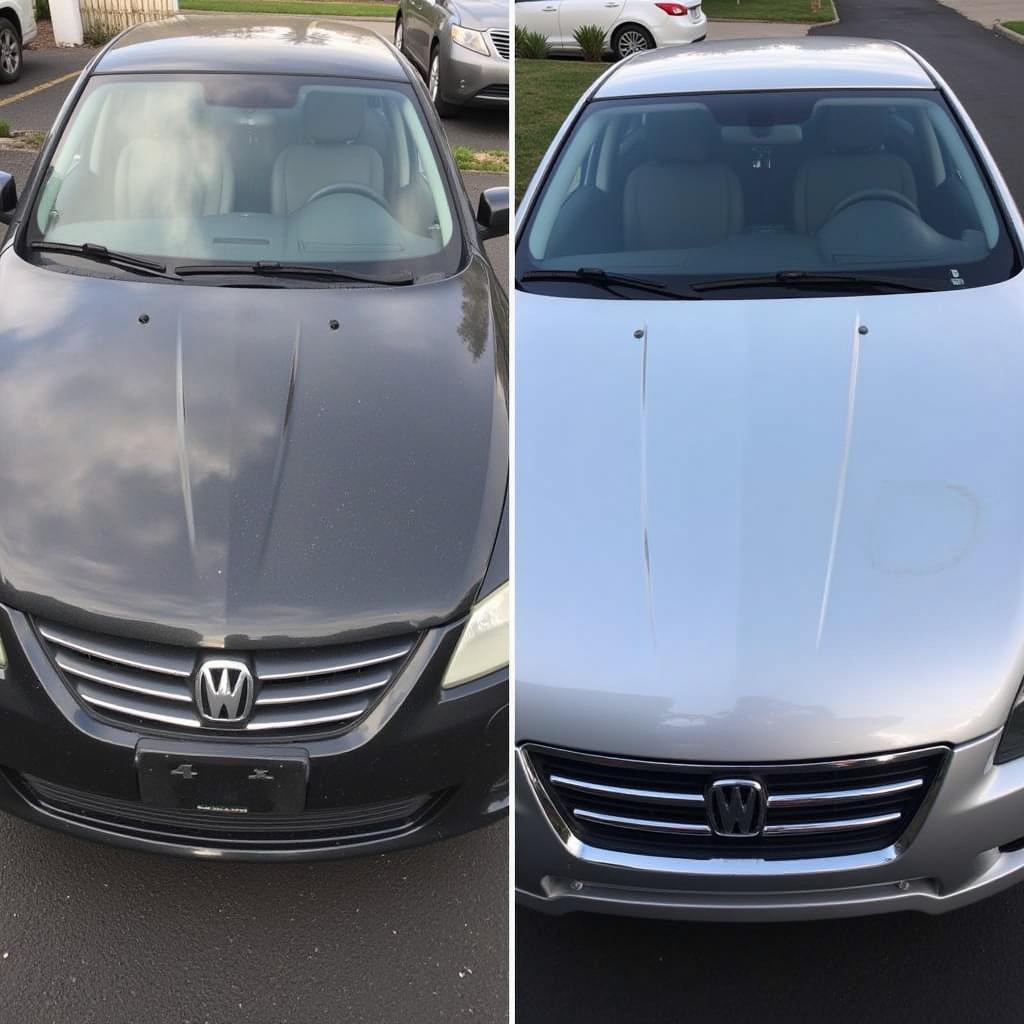Car Wax Detail is the secret to transforming your vehicle from simply clean to truly dazzling. It’s more than just washing and drying; it’s an art form that protects your car’s paint and delivers an unparalleled shine. This guide dives deep into the world of car wax detailing, exploring everything from choosing the right products to achieving professional-level results at home. After reading this, you’ll be equipped to give your car the attention it deserves.
Understanding the Importance of Car Wax Detail
A proper car wax detail not only enhances your car’s appearance but also provides a crucial layer of protection against environmental contaminants, UV rays, and minor scratches. Think of it as a shield for your paintwork, preserving its vibrancy and preventing premature aging. Regular car wax detailing can significantly increase the resale value of your vehicle, making it a worthwhile investment. Beyond the practical benefits, a freshly waxed car simply feels good to own. That mirror-like finish and smooth-to-the-touch surface are testaments to your care and attention to detail. Want to keep your car looking its best between waxes? Check out our guide on the best car detail spray inbetween waxes.
Regular washing removes loose dirt and grime, but it doesn’t address the microscopic imperfections that dull the paint. Car wax detail, on the other hand, fills in these imperfections, creating a smooth surface that reflects light more evenly, resulting in that coveted deep gloss.
 Car Wax Detail Before & After Comparison
Car Wax Detail Before & After Comparison
Choosing the Right Car Wax for Your Detail
With countless car wax products on the market, selecting the right one can be overwhelming. Consider your car’s paint color, the level of protection you need, and the desired finish. Generally, car waxes fall into two main categories: natural and synthetic. Natural carnauba wax offers a warm, deep gloss, while synthetic polymer sealants provide longer-lasting protection and are easier to apply. Finding the perfect balance between durability and aesthetics is key. What are the nuances of a detailed car that smells of wax? You can find more information here.
For darker colored cars, carnauba waxes can truly make the paint pop, revealing a richness and depth that synthetic sealants often can’t match. Lighter colored cars, on the other hand, may benefit more from the durability and protection of a synthetic sealant.
The Car Wax Detailing Process: A Step-by-Step Guide
Before you begin, ensure your car is thoroughly washed and dried. Any remaining dirt or debris can be trapped under the wax, scratching the paint. A clay bar treatment can further remove contaminants embedded in the paint, creating a perfectly smooth surface for the wax.
- Preparation is Key: Wash, dry, and clay bar your car. This creates a clean slate for the wax to adhere to.
- Apply the Wax: Use an applicator pad to apply a thin, even layer of wax, working in small sections. Avoid applying too much, as it can be difficult to remove and may not provide additional benefit.
- Allow to Haze: Let the wax dry to a haze, following the manufacturer’s instructions. This indicates that the solvents have evaporated and the wax is ready to be buffed.
- Buff to a Shine: Using a microfiber towel, buff the wax off in circular motions, revealing the brilliant shine beneath. Flip the towel frequently to expose a clean surface and avoid re-spreading the wax.
Don’t forget to address areas like door jambs, the underside of the hood, and the trunk lid. These areas are often overlooked but can benefit greatly from the added protection of car wax.
Maintaining Your Car Wax Detail
Once your car is gleaming, proper maintenance can prolong the life of the wax. Regular washing with a quality car wash soap and drying with a microfiber towel will help maintain the shine. Avoid automatic car washes, as the harsh brushes can strip the wax and potentially scratch the paint. If you’re looking for car detailing services, check out options in North Liberty or Kingston.
Frequently Asked Questions about Car Wax Detail
- How often should I wax my car? Generally, every 3-4 months is recommended, but this can vary depending on environmental factors and the type of wax used.
- Can I wax my car in direct sunlight? No, direct sunlight can cause the wax to dry too quickly, making it difficult to buff and potentially streaking the finish.
- What’s the difference between car wax and sealant? Car wax typically provides a warmer, deeper gloss, while sealant offers longer-lasting protection.
- Do I need to clay bar my car before waxing? While not always necessary, clay barring removes embedded contaminants and creates a smoother surface for the wax to adhere to, resulting in a better finish.
- Can I use the same applicator pad for different types of wax? It’s best to use separate applicator pads for different waxes to avoid cross-contamination.
Conclusion
Car wax detail is a fundamental aspect of car care that goes beyond mere aesthetics. It’s an investment in your vehicle’s appearance, protection, and resale value. By following the steps outlined in this guide and choosing the right car wax for your needs, you can achieve professional-level results and enjoy a showroom shine that turns heads. For a convenient car wash and detailing experience, consider options available in Blacktown.
 Finished Car Wax Detail with Mirror-like Shine
Finished Car Wax Detail with Mirror-like Shine
Need further assistance? Contact us via WhatsApp: +1(641)206-8880 or Email: [email protected]. Our customer service team is available 24/7.

Leave a Reply